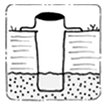Difference between revisions of "Traditional hand-dug wells"
(→Reference manuals, videos, and links) |
|||
| (31 intermediate revisions by 2 users not shown) | |||
| Line 1: | Line 1: | ||
| − | + | {{Language-box|english_link= Traditional hand-dug wells | french_link= Coming soon | spanish_link= Coming soon | hindi_link= Coming soon | malayalam_link= Coming soon | tamil_link= Coming soon | swahili_link=coming soon | korean_link= Coming soon | chinese_link=传统人工钻井 | indonesian_link= Coming soon | japanese_link= Coming soon }} | |
| − | [[Image:traditional hand dug well.png|right]] | + | |
| − | [[Image:StoneLiningHandDugWell.jpg|thumb|right| | + | [[Image:traditional hand dug well.png|right|80px]] |
| + | [[Image:StoneLiningHandDugWell.jpg|thumb|right|200px| Placing a stone lining in a hand dug well. Chiapas, Mexico. Photo: [http://www.flickr.com/photos/aamv/366661815/ The Maya Village Project.]]] | ||
These are shallow wells which draw water from a natural aquifer or man-made aquifer, e.g. near [[sand dam]]s or around [[ponds]], but which are not located inside a riverbed. It can include wells that are far from a river, or wells that receive water from shallow aquifers hydraulically connected to the river. Sometimes the holes dug are very large, allowing people and sometimes animals who are able to walk into the well to where the water is located. <br> | These are shallow wells which draw water from a natural aquifer or man-made aquifer, e.g. near [[sand dam]]s or around [[ponds]], but which are not located inside a riverbed. It can include wells that are far from a river, or wells that receive water from shallow aquifers hydraulically connected to the river. Sometimes the holes dug are very large, allowing people and sometimes animals who are able to walk into the well to where the water is located. <br> | ||
Water extraction can be done with [[Handpumps]] or [[Small and efficient motor pumps]]. A bucket and rope can be used but risk of contamination increases. In such a case, household water treatment should be advocated. | Water extraction can be done with [[Handpumps]] or [[Small and efficient motor pumps]]. A bucket and rope can be used but risk of contamination increases. In such a case, household water treatment should be advocated. | ||
| − | ==Suitable conditions== | + | ===Suitable conditions=== |
* Layers of sand and gravel tend to provide good locations for wells and boreholes. Other good locations are in weathered rock in granite areas, along the edges of valleys in mountainous areas or in a river valley where there may be sandy deposits under the banks. | * Layers of sand and gravel tend to provide good locations for wells and boreholes. Other good locations are in weathered rock in granite areas, along the edges of valleys in mountainous areas or in a river valley where there may be sandy deposits under the banks. | ||
* Care should be taken to avoid siting wells in perched aquifers (shallow aquifers with limited recharge capacity and water storage). | * Care should be taken to avoid siting wells in perched aquifers (shallow aquifers with limited recharge capacity and water storage). | ||
| Line 17: | Line 18: | ||
|- | |- | ||
! width="50%" style="background:#efefef;" | Advantages | ! width="50%" style="background:#efefef;" | Advantages | ||
| − | ! style="background:# | + | ! style="background:#f0f8ff;" | Disadvantages |
|- | |- | ||
| valign="top" | - Manual access, that can be deepened or maintained easily at a later date | | valign="top" | - Manual access, that can be deepened or maintained easily at a later date | ||
| Line 41: | Line 42: | ||
| − | ==Resilience to changes in the environment== | + | ===Resilience to changes in the environment=== |
====Drought==== | ====Drought==== | ||
'''Effects of drought''': Can dry up perched aquifers; Groundwater levels dropping in perched aquifers. | '''Effects of drought''': Can dry up perched aquifers; Groundwater levels dropping in perched aquifers. | ||
| Line 52: | Line 53: | ||
More information on managing drought: [[Resilient WASH systems in drought-prone areas]]. | More information on managing drought: [[Resilient WASH systems in drought-prone areas]]. | ||
| − | ==Construction, operations and maintenance== | + | ===Construction, operations and maintenance=== |
'''General advice on cement''': A common cause of cracks in structures and linings (e.g. in tanks, dams, waterways, wells) is errors in mixing and applying the cement. First of all, it is important that only pure ingredients are used: clean water, clean sand, clean rocks. The materials have to be mixed very thoroughly. Secondly, the amount of water during mixing needs to minimal: the concrete or cement needs to be just workable, on the dry side even, and not fluid. Thirdly, it is essential that during curing the cement or concrete is kept moist at all times, for at least a week. Structures should be covered with plastic, large leaves or other materials during the curing period, and kept wet regularly. | '''General advice on cement''': A common cause of cracks in structures and linings (e.g. in tanks, dams, waterways, wells) is errors in mixing and applying the cement. First of all, it is important that only pure ingredients are used: clean water, clean sand, clean rocks. The materials have to be mixed very thoroughly. Secondly, the amount of water during mixing needs to minimal: the concrete or cement needs to be just workable, on the dry side even, and not fluid. Thirdly, it is essential that during curing the cement or concrete is kept moist at all times, for at least a week. Structures should be covered with plastic, large leaves or other materials during the curing period, and kept wet regularly. | ||
'''Specific advice''': | '''Specific advice''': | ||
| − | [[Image:telescopic lining.jpg|thumb|right| | + | [[Image:telescopic lining.jpg|thumb|right|200px|Hand-dug well with telescopic lining. Diagram: Watt, S.B.; Wood, W.E. (1979) Hand Dug Wells and their Construction. IT, London, UK.]] |
| − | [[Image:HandDugWellConstruction.jpg|thumb|right| | + | [[Image:HandDugWellConstruction.jpg|thumb|right|200px|Construction of hand dug well at Kulala Kebele, Dera Woreda, Amhara Region, Ethiopia. Photo: [http://www.flickr.com/photos/waterdotorg/4923124025/ Water.org]]] |
The basic elements of a hand-dug well are illustrated in Figure 5.3. The three main elements are: <br> | The basic elements of a hand-dug well are illustrated in Figure 5.3. The three main elements are: <br> | ||
A. '''The Well Head''' - this is the part of the well which is visible above the ground. It generally consists of a protective apron and a superstructure which depends on the type of extraction system in use. <br> | A. '''The Well Head''' - this is the part of the well which is visible above the ground. It generally consists of a protective apron and a superstructure which depends on the type of extraction system in use. <br> | ||
| Line 80: | Line 81: | ||
Simplify construction methods while getting a more robust end product in a safer fashion. Using lining & telescopic lining has the advantage that heavy lifting equipment for pre-cast rings is obsolete while procedures are inherently safer. Lining is made using one-skin moulds that hold concrete against the dug wall of the hole, while the telescopic shaft can be made from curved blocks built onto a foundation cutting ring – the blocks can be extended as and when necessary. | Simplify construction methods while getting a more robust end product in a safer fashion. Using lining & telescopic lining has the advantage that heavy lifting equipment for pre-cast rings is obsolete while procedures are inherently safer. Lining is made using one-skin moulds that hold concrete against the dug wall of the hole, while the telescopic shaft can be made from curved blocks built onto a foundation cutting ring – the blocks can be extended as and when necessary. | ||
| − | ==Costs== | + | ===Costs=== |
| − | Hand-dug wells can provide a viable alternative to unhygienic, unprotected sources while avoiding the capital and maintenance costs associated with sophisticated drilling programmes or reticulated pumped systems. A range of lining types and water lifting technologies can be chosen to match the financial and management capacity of the participants in the water supply process. | + | Hand-dug wells can provide a viable alternative to unhygienic, unprotected sources while avoiding the capital and maintenance costs associated with sophisticated drilling programmes or reticulated pumped systems. A range of lining types and water lifting technologies can be chosen to match the financial and management capacity of the participants in the water supply process. |
| + | |||
| + | ===Field experiences=== | ||
| + | The following projects are utilizing hand dug well techniques. | ||
| + | <br> | ||
| + | {{RSR_table | ||
| + | |1image=project 1365.jpg |1link=http://rsr.akvo.org/project/1365/ |1project#=1365 |1project name=Facilities Ibbagamuwa school Sri Lanka | | ||
| + | |2image=project 1349.jpg |2link=http://rsr.akvo.org/project/1349/ |2project#=1349 |2project name=Safe water <br>for Wajir | | ||
| + | |3image=project 822.png |3link=http://rsr.akvo.org/project/822/ |3project#=822 |3project name=Urban WASH II <br>in Monrovia | | ||
| + | |4image=project 894.png |4link=http://rsr.akvo.org/project/894/ |4project#=894 |4project name=Senjeh Well <br>Restoration | | ||
| + | |5image=project 896.png |5link=http://rsr.akvo.org/project/896/ |5project#=896 |5project name=Gboto Well <br>Restoration | | ||
| + | }} | ||
| + | {|style="border: 2px solid #e0e0e0; width: 60%; text-align: justify; background-color: #e9f5fd;" cellpadding="2" | ||
| + | |- style="vertical-align: top" | ||
| + | |[[Image:akvorsr logo_lite.png|center|60px|link=http://akvo.org/products/rsr/]] | ||
| + | |- style="vertical-align: bottom" | ||
| + | |[[Image:project 922.png |thumb|center|140px|<font size="2"><center>[http://rsr.akvo.org/project/922/ RSR Project 922]<br>WaterAid Rural <br>WASH Project</center></font>|link=http://rsr.akvo.org/project/922/ ]] | ||
| + | |[[Image:project 933.png |thumb|center|140px|<font size="2"><center>[http://rsr.akvo.org/project/933/ RSR Project 933]<br>Accelerating Sanitation and Water for All 1</center></font>|link=http://rsr.akvo.org/project/933/ ]] | ||
| + | |[[Image:project 1330.png |thumb|center|140px|<font size="2"><center>[http://rsr.akvo.org/project/1330/ RSR Project 1330]<br>WASH services & capacity building Liberia</center></font>|link=http://rsr.akvo.org/project/1330/ ]] | ||
| + | |} | ||
| − | + | <br> | |
| − | == | + | ===Manuals, videos and links=== |
| + | * [http://www.indiawaterportal.org/articles/well-revival-effort-sees-many-other-benefits Well revival effort sees many other benefits] A community drive to revive wells in Mokhla talab near Udaipur results in water security for longer periods of time as well as making leaders out of women. | ||
| + | * [http://www.indiawaterportal.org/articles/experiments-community-wells Experiments with 'community wells'] Mobilized farmers in Dhule, Maharashtra, show how communities can use groundwater as a common resource in an organised and collective manner. | ||
* [http://www.rural-water-supply.net/en/resources/details/256 Hand dug shallow wells (Skat)]. Includes construction information plus covers lining options. Also a good section on environmental, social, and cultural considerations. Swiss Centre for Development Cooperation in Technology and Management. | * [http://www.rural-water-supply.net/en/resources/details/256 Hand dug shallow wells (Skat)]. Includes construction information plus covers lining options. Also a good section on environmental, social, and cultural considerations. Swiss Centre for Development Cooperation in Technology and Management. | ||
| − | * [http://www.consallen.com | + | * [http://www.rural-water-supply.net/en/implementation/hand-dug-wells Hand Dug Wells] section of the Rural Water Supply Network website |
| + | * [http://www.consallen.com/ Consallen]. An excellent guide to a relatively safe method of digging hand dug wells by the highly experienced British Drilling Company. | ||
* [http://www.fao.org/docrep/X5567E/x5567e06.htm#5.%large%diameter%wells Large Diameter Wells]. An excellent but slightly outdated summary of hand dug wells by Koegel, made available by the UN FAO. | * [http://www.fao.org/docrep/X5567E/x5567e06.htm#5.%large%diameter%wells Large Diameter Wells]. An excellent but slightly outdated summary of hand dug wells by Koegel, made available by the UN FAO. | ||
* [http://www.clean-water-for-laymen.com/hand-dug-wells.html Hand Dug Wells and Other Manual Methods to Dig a Well Have Been in Existence for Thousands of Years]. Compares different methods of digging a well, includes hand-dug method. | * [http://www.clean-water-for-laymen.com/hand-dug-wells.html Hand Dug Wells and Other Manual Methods to Dig a Well Have Been in Existence for Thousands of Years]. Compares different methods of digging a well, includes hand-dug method. | ||
| + | * Old style of excavated wells in India: [http://www.greatmirror.com/index.cfm?navid=169 India Themes: Irrigation 1: Ancient Methods.] | ||
| − | ==Acknowledgements== | + | ===Acknowledgements=== |
| − | * CARE Nederland, | + | * CARE Nederland, Desk Study: [[Resilient WASH systems in drought-prone areas]] October 2010. |
| − | * Collins, Seamus, [http://www.rural-water-supply.net/en/resources/details/256 Hand dug shallow wells ( | + | * Collins, Seamus, [http://www.rural-water-supply.net/en/resources/details/256 Hand dug shallow wells (Skat)]. Swiss Centre for Development Cooperation in Technology and Management. 2000. |
Latest revision as of 23:37, 5 September 2016
| |
|
|
|
|
|
|
|
|
|
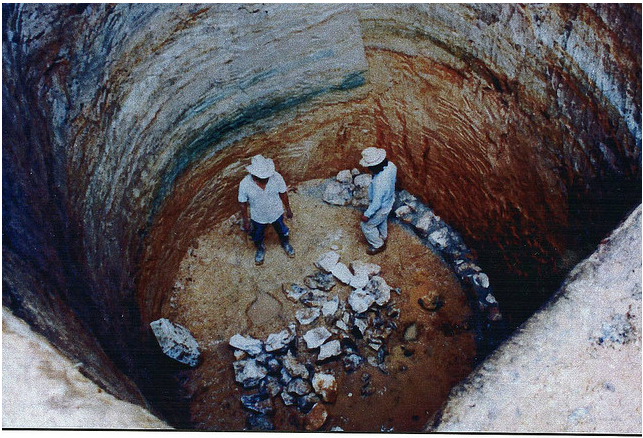
These are shallow wells which draw water from a natural aquifer or man-made aquifer, e.g. near sand dams or around ponds, but which are not located inside a riverbed. It can include wells that are far from a river, or wells that receive water from shallow aquifers hydraulically connected to the river. Sometimes the holes dug are very large, allowing people and sometimes animals who are able to walk into the well to where the water is located.
Water extraction can be done with Handpumps or Small and efficient motor pumps. A bucket and rope can be used but risk of contamination increases. In such a case, household water treatment should be advocated.
Contents
Suitable conditions
- Layers of sand and gravel tend to provide good locations for wells and boreholes. Other good locations are in weathered rock in granite areas, along the edges of valleys in mountainous areas or in a river valley where there may be sandy deposits under the banks.
- Care should be taken to avoid siting wells in perched aquifers (shallow aquifers with limited recharge capacity and water storage).
Avoid contamination
Site wells at a sufficient distance away from sources of contamination. For microbiological contamination, the distance from the source of contamination (e.g. latrine) to the water intake (screen) needs to be sufficient so as to pose a “low” to “very low” risk – this translates into a minimum of 25 days of potential travel of pathogens in the ground. Travel time is influenced by porosity, hydraulic conductivity (permeability) and hydraulic gradient. For medium size sand with an average porosity, the distance equivalent to 25 days is around 30 metres, but this can increase to over 100 metres for coarser sediments. However, the distance from contamination to water intake can reduce significantly where the screen intake is at a sufficient depth – this is due to greater variation of aquifer properties in vertical directions than lateral, meaning that a borehole with handpump could be placed very close to a latrine with low risk. However, screen depth must increase with increased extraction rate.
| Advantages | Disadvantages |
|---|---|
| - Manual access, that can be deepened or maintained easily at a later date
- Can be privately owned/operated
|
- Greater effort and longer construction time
- Greater safety hazards during and after construction |
Resilience to changes in the environment
Drought
Effects of drought: Can dry up perched aquifers; Groundwater levels dropping in perched aquifers.
Underlying causes of effects: Less recharge of aquifer due to less rainfall; Increasing population & water demand; Size of aquifers – e.g. perched aquifers will be used up faster; Wells not dug deep enough into water table.
To increase resiliency of WASH system: Avoid perched aquifers; Dig wells deeper – de-water well during caissoning within the water table; Allow for subsequent deepening by using telescopic lining; Dig wells during the latter half of the dry season; Recharge aquifer through Managed Aquifer Recharge (MAR) boreholes; Jet in the bottom of the well to provide a means of faster recharge; Increase flow by use of porous concrete or perforated pointed steel pipes driven horizontally into the aquifer.
More information on managing drought: Resilient WASH systems in drought-prone areas.
Construction, operations and maintenance
General advice on cement: A common cause of cracks in structures and linings (e.g. in tanks, dams, waterways, wells) is errors in mixing and applying the cement. First of all, it is important that only pure ingredients are used: clean water, clean sand, clean rocks. The materials have to be mixed very thoroughly. Secondly, the amount of water during mixing needs to minimal: the concrete or cement needs to be just workable, on the dry side even, and not fluid. Thirdly, it is essential that during curing the cement or concrete is kept moist at all times, for at least a week. Structures should be covered with plastic, large leaves or other materials during the curing period, and kept wet regularly.
Specific advice:
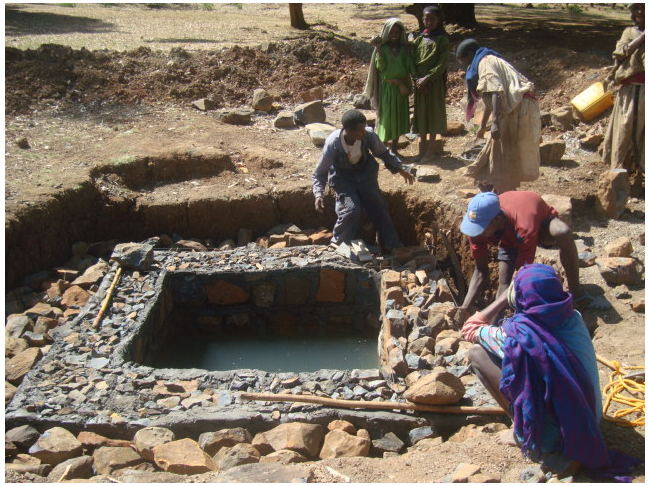
The basic elements of a hand-dug well are illustrated in Figure 5.3. The three main elements are:
A. The Well Head - this is the part of the well which is visible above the ground. It generally consists of a protective apron and a superstructure which depends on the type of extraction system in use.
B. The Well Shaft
C. The Intake - this is the part of the well in contact with the aquifer. It is constructed in such a way that water flows from the aquifer into the well, from where it can be extracted using a bucket, a pump or another method.
Hand-dug wells have a tendency to have very little water or even dry up in the dry season. This is largely to do with the fact that the intake area is not deep enough inside the dry season water table. Shallow aquifers tend to reflect recharge more sharply than deeper aquifers, resulting in water table fluctuations of several metres between seasons – these fluctuations need to be accounted for in the construction method. Several techniques can ensure that wells are sunk deep enough:
- Construct wells using a telescopic system, where an a permanent lining is created above the water table, together with a smaller diameter telescopic lining that enters the water table. The advantage of this system is that the smaller lining can be deepened at a later date without affecting the permanent lining and slab, e.g. in case the well was not sunk deep enough the first time. Another advantage is that the shaft has less chance to go out of vertical alignment during caissoning (where a shaft is sunk by digging).
- Use an effective method of de-watering during caissoning within the water table. Many hand-dug wells are dug without using a de-watering pump – consequently, the limit of penetration into the water table is about only 1 metre. Providing a de-watering pump will allow the shaft to be sunk deeper into the water table, but note:
- Type of pump depends on the height from ground level to water table – for a suction pump, the limit will be 6-7 metres, after which a submersible pump and generator needs to be considered. The type of pump should allow a certain amount of solid particles to be pumped.
- Attention needs to be given to safety considerations when using a motorized pump with someone digging in the well – engines should be located downwind so fumes do not enter the well, a 100 – 150mm vent pipe can be temporarily tied to the crossbeam to ventilate the well (in similar way to a VIP latrine), submersible pumps should be fitted with circuit breakers in case of electrical shortcuts to avoid electrocution, digger should be wearing construction harness attached to rope, and rescue & recovery action should be in place and practised regularly.
- Where using a de-watering pump results in subsidence around the well (in the case of flowing sands), another idea is to use a bailer instead of a pump. A bailer is normally used in percussion drilling, and consists of a heavy hollow metal tube with a valve on the bottom. When the bailer is dropped, sediment enters which does not come out when the bailer is removed. This method takes longer, but can be performed at ground level without a de-watering pump – since the water is not being pumped, flowing sand has less incentive to enter and the well shaft can sink slowly.
- Aim to dig wells during the latter half of the dry season when water table will be at their lowest.
Where deepening the well further is not possible due to water/sand ingress, jetting in the bottom of the well can provide a means of faster recharge into the well from deeper in the aquifer, meaning the well dries up less quickly. In this case a larger diameter screen (can be wrapped with geotextile) is jetted into the well base with the end protruding above the bottom of the well, after which it is plugged using a small bag of gravel.
Where wells still dry up in the dry season, recharge techniques could be used upstream of the well.
The use of porous concrete in part of the section of the well shaft which is underwater can help increase flow velocity into the well. Porous concrete is made using a of 1 : 1 : 4 (cement : sand : aggregate) and can be used for curved blocks or also for a central portion of any pre-cast concrete ring. Also perforated pointed steel pipes can be driven horizontally into the aquifer using a jack – this can also increase flow velocity into the well.
Simplify construction methods while getting a more robust end product in a safer fashion. Using lining & telescopic lining has the advantage that heavy lifting equipment for pre-cast rings is obsolete while procedures are inherently safer. Lining is made using one-skin moulds that hold concrete against the dug wall of the hole, while the telescopic shaft can be made from curved blocks built onto a foundation cutting ring – the blocks can be extended as and when necessary.
Costs
Hand-dug wells can provide a viable alternative to unhygienic, unprotected sources while avoiding the capital and maintenance costs associated with sophisticated drilling programmes or reticulated pumped systems. A range of lining types and water lifting technologies can be chosen to match the financial and management capacity of the participants in the water supply process.
Field experiences
The following projects are utilizing hand dug well techniques.
 Facilities Ibbagamuwa school Sri Lanka |
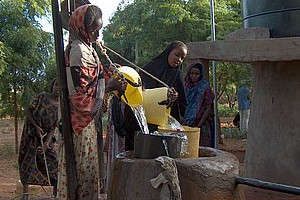 Safe water for Wajir |
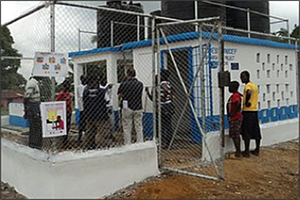 Urban WASH II in Monrovia |
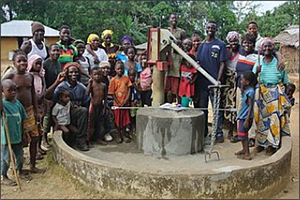 Senjeh Well Restoration |
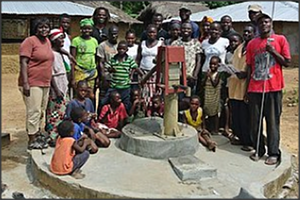 Gboto Well Restoration | ||
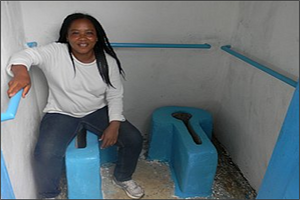 WaterAid Rural WASH Project |
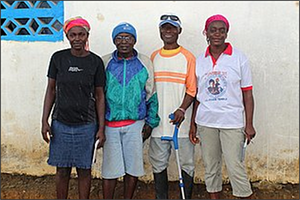 Accelerating Sanitation and Water for All 1 |
 WASH services & capacity building Liberia |
Manuals, videos and links
- Well revival effort sees many other benefits A community drive to revive wells in Mokhla talab near Udaipur results in water security for longer periods of time as well as making leaders out of women.
- Experiments with 'community wells' Mobilized farmers in Dhule, Maharashtra, show how communities can use groundwater as a common resource in an organised and collective manner.
- Hand dug shallow wells (Skat). Includes construction information plus covers lining options. Also a good section on environmental, social, and cultural considerations. Swiss Centre for Development Cooperation in Technology and Management.
- Hand Dug Wells section of the Rural Water Supply Network website
- Consallen. An excellent guide to a relatively safe method of digging hand dug wells by the highly experienced British Drilling Company.
- Large Diameter Wells. An excellent but slightly outdated summary of hand dug wells by Koegel, made available by the UN FAO.
- Hand Dug Wells and Other Manual Methods to Dig a Well Have Been in Existence for Thousands of Years. Compares different methods of digging a well, includes hand-dug method.
- Old style of excavated wells in India: India Themes: Irrigation 1: Ancient Methods.
Acknowledgements
- CARE Nederland, Desk Study: Resilient WASH systems in drought-prone areas October 2010.
- Collins, Seamus, Hand dug shallow wells (Skat). Swiss Centre for Development Cooperation in Technology and Management. 2000.
